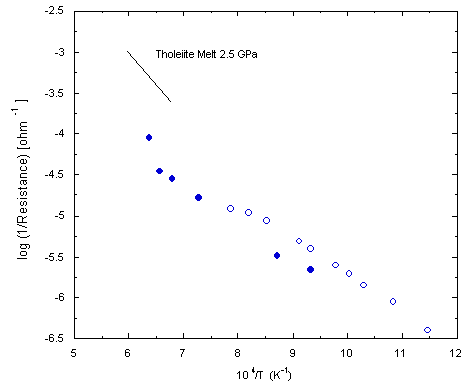

Determination of the electrical conductivities of melts and other materials at elevated pressures can provide not only information on melt structural changes with pressure but also information important for the interpretation of earth electrical conductivity profiles. In Fig. 3.5-4 we show preliminary measurements of the electrical conductivity of a mid-ocean ridge basalt in the multiple anvil device at about 8 GPa over the temperature range 600 to 1300°C in a 14/8 assembly using techniques developed by Xu et al. (J. Geophys. Res., 105, 27865, 2000). A molten sample presents the additional challenge of maintaining an electrically insulated sample in contact with two electrodes without sample leakage or deformation. The data suggest a possible softening, reaction, or crystallization of the sample in the range of about 950 to 1000°C during the initial heating cycle (open symbols). After high temperatures (1200°C) had been reached, cycling the temperature up and down yielded a linear trend in 1/R versus 1/T between 800 and 1250°C (filled symbols) with an activation energy of 0.90 eV.
 |
The value at 1300°C, the highest temperature achieved, deviates from this trend and is about one-half of an order of magnitude lower in conductivity than that of an Hawaiian tholeiite at 2.5 GPa. The activation energy for the tholeiitic melt is 1.5 eV. The results of these experiments are particularly important for our understanding of the electrical properties of partially molten systems, for which measurements are currently ongoing.

Tel: +49-(0) 921 55 3700 / 3766, Fax: +49-(0) 921 55 3769, E-mail: bayerisches.geoinstitut(at)uni-bayreuth.de
 Previous page
Previous page